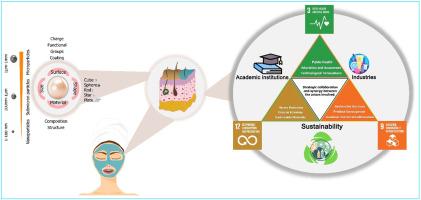30年的科学遗产和纳米粒子在下一代化妆品应用的未来
IF 4.3
2区 材料科学
Q2 ENGINEERING, CHEMICAL
引用次数: 0
摘要
本研究分析了30年来(1993-2023年)纳米颗粒(NPs)在化妆品中应用的进展,描绘了从传统化妆品到药妆的转变。在科学创新、消费者对多功能产品的需求和可持续性的推动下,这种转变整合了美学和治疗效益。药妆,由阿尔伯特·克利格曼推广,结合了化妆品和药物的特性。20世纪90年代引入了果酸等生物活性成分,而21世纪初则强调天然、环保的材料。纳米技术在2010年代尤为突出,它引入了纳米载体,如脂质体和固体脂质NPs,增强了皮肤渗透和靶向递送,用于抗衰老、防紫外线和护发。在纳米药妆品的推动下,化妆品市场从2017年的5324.3亿美元增长到2023年预计的8056.1亿美元。最近的趋势集中在使用纤维素纳米纤维等可生物降解材料和可持续实践的绿色合成上,例如欧莱雅集团到2025年实现零塑料污染的目标。监管的不确定性和纳米毒性问题仍然存在,这凸显了对安全、可持续创新的需求,以塑造该行业的未来。本文章由计算机程序翻译,如有差异,请以英文原文为准。

30-year scientific legacy and future of nanoparticles in next-generation cosmetic applications
This study analyzes 30 years (1993–2023) of advancements in nanoparticle (NPs) use in cosmetics, mapping the shift from traditional cosmetics to cosmeceuticals. This transition integrates aesthetic and therapeutic benefits, driven by scientific innovation, consumer demand for multifunctional products, and sustainability. Cosmeceuticals, popularized by Albert Kligman, combine cosmetic and pharmaceutical properties. The 1990s introduced bioactive ingredients like alpha-hydroxy acids, while the 2000s emphasized natural, eco-friendly materials. Nanotechnology, prominent in the 2010s, introduced nanocarriers like liposomes and solid lipid NPs, enhancing skin penetration and targeted delivery for anti-aging, UV protection, and hair care. The cosmetics market grew from USD 532.43 billion in 2017 to a projected USD 805.61 billion by 2023, driven by nanocosmeceuticals. Recent trends focus on green synthesis using biodegradable materials like cellulose nanofibers and sustainable practices, exemplified by L’Oréal's zero plastic pollution goal by 2025. Regulatory uncertainties and nanotoxicity concerns remain, underscoring the need for safe, sustainable innovations to shape the industry's future.
求助全文
通过发布文献求助,成功后即可免费获取论文全文。
去求助
来源期刊

Particuology
工程技术-材料科学:综合
CiteScore
6.70
自引率
2.90%
发文量
1730
审稿时长
32 days
期刊介绍:
The word ‘particuology’ was coined to parallel the discipline for the science and technology of particles.
Particuology is an interdisciplinary journal that publishes frontier research articles and critical reviews on the discovery, formulation and engineering of particulate materials, processes and systems. It especially welcomes contributions utilising advanced theoretical, modelling and measurement methods to enable the discovery and creation of new particulate materials, and the manufacturing of functional particulate-based products, such as sensors.
Papers are handled by Thematic Editors who oversee contributions from specific subject fields. These fields are classified into: Particle Synthesis and Modification; Particle Characterization and Measurement; Granular Systems and Bulk Solids Technology; Fluidization and Particle-Fluid Systems; Aerosols; and Applications of Particle Technology.
Key topics concerning the creation and processing of particulates include:
-Modelling and simulation of particle formation, collective behaviour of particles and systems for particle production over a broad spectrum of length scales
-Mining of experimental data for particle synthesis and surface properties to facilitate the creation of new materials and processes
-Particle design and preparation including controlled response and sensing functionalities in formation, delivery systems and biological systems, etc.
-Experimental and computational methods for visualization and analysis of particulate system.
These topics are broadly relevant to the production of materials, pharmaceuticals and food, and to the conversion of energy resources to fuels and protection of the environment.
 求助内容:
求助内容: 应助结果提醒方式:
应助结果提醒方式:


